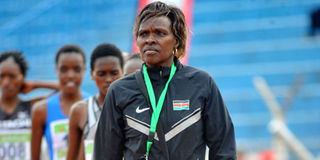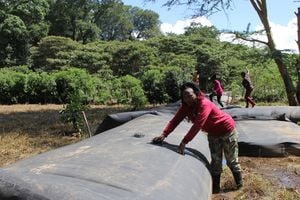Barefoot, and in a petticoat: Kenya’s piooneer runners who beat the odds to shine

Rose Tata Muya leads athletes who were set to take part in the 10,000m during the Kenyan trials for the IAAF World Championship on June 23, 2017 at Nyayo Stadium.
What you need to know:
- Middle distance runner Chebichi ran barefoot, wearing just a petticoat, and won her first race in 1973
- Another barefoot sensation was Rose Tata-Muya who told me recently how she ran barefoot in Mombasa in 1975 while wearing just a petticoat
- Tecla Chemabwai, a pioneer female runner, also impressed in track and field events. She competed at the 1968 Olympic Games in Mexico but did not go past the heats
They did not benefit from advanced technology such as wavelight that enables athletes to better target a specific pace, or shoe technology (some ran without shoes) that enables them to run effortlessly, but they went on to set the pace for those who came after them.
As Kenyans and the rest of the athletics fraternity the world over bid farewell to the late legendary runner, Wilson Kiprugut Chumo, the first Kenyan to win an Olympic medal (a bronze in 800m at the 1964 Olympic Games in Tokyo), we look back at the struggles some of them went through running without shoes and wearing pants that made some kind of history on their own.
I am one of the thousands of fans who used to fill Ruring’u Stadium in Nyeri County to the rafters in the early 1960s to watch established athletes and newcomers try to outdo each other. Those were the days when both the old and young fans turned out in style to cheer their favourites.
Among the athletes spectators loved to see in action were Nyandika Maiyoro, Chumo (whom many called Chuma for years), Arere Anentia, Daniel Rudisha and Kipchoge Keino.
Most of the locals who competed among the well established athletes ran barefoot and their running pants became a big issue, especially in long distance races such as three miles (5000 metres) and six miles (10,000m). With a lot of cheering from the crowd, the locals would accelerate, and a lot of foam would form from under the armpits.
However, it was the running pant from one of the local runners that would cause more wild cheers as spectators sought to urge the man to run faster, while at the same time guard his private parts that would already have be exposed due to friction between the legs. That would affect the position of the pant.
Despite all these challenges, the cheering crowd would give the man a standing ovation for his determination even if he did not win the race. It is this spirit that has transformed our athletes over the years to be what they are world over.
Female athletes, too, have had their share of challenges as they tried to prove their worth in the sport.
Female athletes like the late Sabina Chebichi who, as a teenager ran barefoot and wearing just a petticoat, won her first race in 1973. The middle distance runner would later win race after race against more experienced athletes.
Born in 1959 in Trans-Nzoia County, she became the first Kenyan female athlete to win a medal at the Commonwealth Games when she claimed bronze in women’s 800m at the 1974 games held in Christchurch, New Zealand.
She surprised many and acquired the name "Petticoat Princess.” You only need to see the variety of photographs where she is in action to understand the kind of natural talent she possessed.
Upon being told of a young school girl who was competing in races and winning without proper gear, Feisal Sherman who was at the time the secretary of Kenya Amateur Athletics Association (now Athletics Kenya) sent her a running kit.
Another barefoot sensation was Rose Tata-Muya who told me recently how she ran barefoot in Mombasa in 1975 while wearing just a petticoat. She did so well in that particular race, watched by among others First Lady Mama Ngina Kenyatta who was so impressed and moved, she bought her the necessary running gear.
Tata-Muya went on to become one of the best athletes in 400m hurdles and represented Kenya far and wide.
“Some people come from seriously challenging backgrounds, and it is not their fault when you see them not wearing the right clothes during training, or when running. I am proud of my achievements for my country despite the many challenges I faced in those early days," she says.
Tecla Chemabwai, a pioneer female runner, also impressed in track and field events. She competed at the 1968 Olympic Games in Mexico but did not go past the heats.
Along with Lydia Stephens-Oketch and Elizabeth Chesire, they were the first female Kenyan athletes to compete at the Olympics. She won 400m race at the 1973 All Africa Games, becoming the first Kenyan woman to win a gold medal at the championships.
With determination, there is hope that Kenyan athletes will go far.
Kiprugut Chumo and others like him have inspired many young athletes, and they should not be forgotten.



